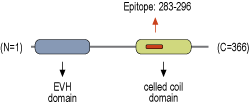Overview
- Peptide (C)KQEIDNARELQEQR, corresponding to amino acid residues 293-296 of rat Homer1 (Accession Q9Z214). Intracellular.

 Western blot analysis of mouse brain membranes (lanes 1 and 3) and rat brain synaptosomal fractions (lanes 2 and 4):1,2. Anti-Homer1 Antibody (#APZ-026), (1:500).
Western blot analysis of mouse brain membranes (lanes 1 and 3) and rat brain synaptosomal fractions (lanes 2 and 4):1,2. Anti-Homer1 Antibody (#APZ-026), (1:500).
3,4. Anti-Homer1 Antibody, preincubated with Homer1 Blocking Peptide (#BLP-PZ026).
 Expression of Homer1 in mouse hippocampus and striatumImmunohistochemical staining of perfusion-fixed frozen mouse brain sections using Anti-Homer1 Antibody (#APZ-026), (1:400), followed by goat-anti-rabbit-AlexaFluor-488 secondary antibody. A. Homer1 staining (green) in hippocampal dentate gyrus region, is detected in neuronal soma (arrows). B. Homer1 staining in the striatum region, also shows labeling in neuronal soma (arrows). Cell nuclei are stained with DAPI (blue).
Expression of Homer1 in mouse hippocampus and striatumImmunohistochemical staining of perfusion-fixed frozen mouse brain sections using Anti-Homer1 Antibody (#APZ-026), (1:400), followed by goat-anti-rabbit-AlexaFluor-488 secondary antibody. A. Homer1 staining (green) in hippocampal dentate gyrus region, is detected in neuronal soma (arrows). B. Homer1 staining in the striatum region, also shows labeling in neuronal soma (arrows). Cell nuclei are stained with DAPI (blue).
- Hayashi, M.K. et al. (2006) J. Neurosci. 26, 8492.
- Tappe, A. and Kuner, R. (2005) Proc. Natl. Acad. Sci. U.S.A. 103, 774.
- Feng, W. et al. (2008) Cell Calcium 43, 307.
Homer proteins regulate signal transduction, generation of synapses and receptor trafficking. The homer protein family is comprised of three members with each member alternatively spliced to long and short forms. All members of the Homer family are synaptic scaffolding proteins with an N-terminal EVH (Ena/VASP homology 1) and a C-terminal coiled-coil domain. Long forms of the protein contain both EVH1 and coiled-coil domains and are constitutively expressed, whereas the short forms contain only the EVH1 domain and are expressed in an activity dependent manner1.
The long form of Homer1 assembles group 1 metabotropic glutamate receptors mGluR1 and mGluR5 in large macromolecular complexes at synapses as well as with components of the NMDA receptor complex at the neuronal cell membrane. In contrast, the short form of Homer1 lacks the ability of linking mGluR1/5 to synaptic proteins and functions as an endogenous negative modulator of the mGluR1/5-inositol 1,4,5-trisphosphate receptor signaling complex. Transgenic mice with overexpressed Homer1 in striatal medium spiny neurons demonstrate normal development of striatal structure and afferent/efferent connectivity. However, motor performance in behavioral tasks and striatal responses to the psychomotor stimulant amphetamine are significantly altered in these mice2.
At concentrations <200 nM of ryanodine, long and short forms of Homer1 enhance specific ryanodine binding to Ryanodine receptor 1 (RyR1). Interestingly, at larger concentrations both forms completely inhibit ryanodine binding to its receptor. Combinations of the two forms act in an additive manner to enhance or inhibit ryanodine binding activity3.
Application key:
Species reactivity key:
Anti-Homer1 Antibody (#APZ-026) is a highly specific antibody directed against an epitope of the rat protein. The antibody can be used in western blot and immunohistochemistry applications. It has been designed to recognize Homer1 from human, mouse, and rat samples. The antibody will not recognize Homer1 short isoform 3 (also known as Homer1a), but will recognize isoform 2 (also known as Homer1b).
